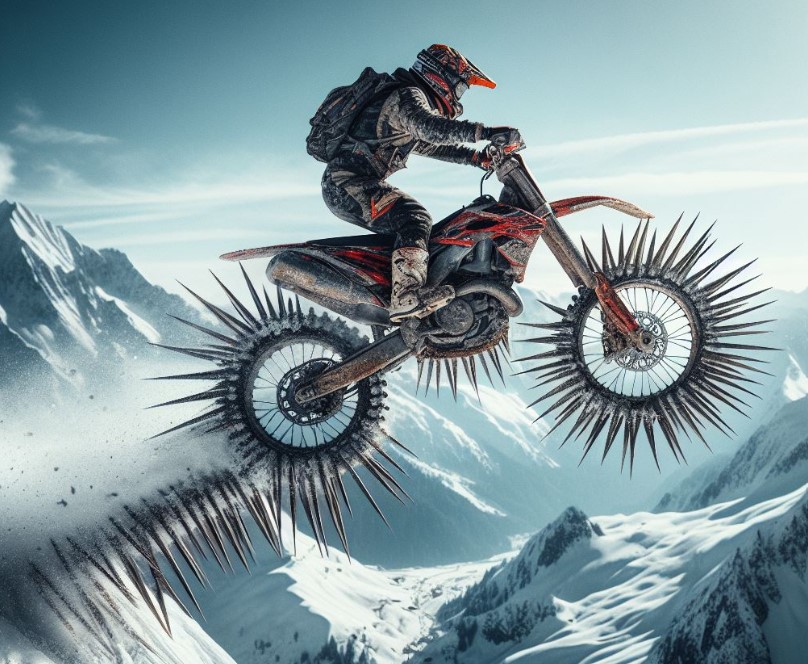Can You Ride A Dirt Bike In The Snow? Answered
Are you looking for Can You Ride A Dirt Bike In The Snow? The simple answer is yes, but it requires proper preparation, equipment, and safety measures to ensure a fun and secure experience. Riding a dirt bike in the snow is an exhilarating experience that offers a unique set of challenges and rewards. Whether you’re an experienced rider looking for a new adventure or a beginner curious about the possibilities, it’s essential to understand what riding in the snow entails.
Key Takeaways
- Yes, you can ride a dirt bike in the snow with proper preparation.
- Special equipment such as studded tires or snow tracks may be necessary.
- Adjusting riding techniques to accommodate for slippery conditions is crucial.
- Safety gear and awareness of the environment are paramount.
Can You Ride A Dirt Bike In The Snow?
Yes, you can ride a dirt bike in the snow. However, this activity is not as straightforward as regular dirt biking. Snow riding requires modifications to your bike, a change in your riding techniques, and additional safety precautions to tackle the slippery terrain and cold weather conditions effectively.

Necessary Equipment and Modifications
To ride a dirt bike in the snow successfully, you might need to equip your bike with studded tires or snow tracks. These modifications increase traction on snow and ice, making it easier to control your bike. Additionally, adjusting the air pressure in your tires can improve grip and performance in snowy conditions.
Adjusted Riding Techniques
Riding a dirt bike in the snow demands different techniques than riding on dry land. You’ll need to learn how to manage your bike’s throttle and brakes more delicately to avoid slipping. Body positioning and weight distribution also play a vital role in maintaining balance and control.
Preparing Your Dirt Bike for Snow
Preparing your dirt bike for snow involves more than just adding the right equipment. You also need to ensure your bike is in top condition to withstand the cold and wet environment.
Mechanical Checks and Adjustments
Before venturing out into the snow, perform a thorough check of your bike’s mechanical components. This includes the engine, brakes, and suspension system. Cold weather can affect your bike’s performance, so make adjustments accordingly.
Protecting Your Bike from the Cold
To protect your bike from the cold, consider using a higher-viscosity oil that performs better in low temperatures. Additionally, ensure your bike’s radiator and cooling system are adequately protected from freezing.
Safety Gear and Considerations
Riding in the snow increases the risk of accidents and exposure to cold temperatures. Therefore, wearing the appropriate safety gear is crucial.
Essential Safety Gear
Your safety gear should include a DOT-approved helmet, goggles with anti-fog lenses, waterproof riding boots, gloves, and thermal layers. This gear will not only protect you from injuries but also keep you warm.
Environmental Awareness
Being aware of your environment and the potential hazards of snow riding is crucial. This includes understanding the terrain, being mindful of hidden obstacles under the snow, and recognizing the signs of hypothermia or frostbite.
Training and Skills Development
Riding a dirt bike in the snow requires a unique set of skills. Consider taking a training course or practicing in a safe, controlled environment before tackling more challenging terrains.
Learning from Experienced Riders
Seeking advice and learning from experienced snow riders can provide valuable insights and tips on handling your bike in snowy conditions.
Practicing in Safe Conditions
Start by practicing on familiar trails with less snow accumulation. This will help you gradually build your confidence and skills for riding in more challenging snowy conditions.
Environmental Consideration and Etiquette
Riding a dirt bike in the snow can have environmental impacts. Always practice responsible riding by sticking to designated trails and avoiding sensitive habitats.
Respecting Wildlife and Nature
Be mindful of the wildlife and natural surroundings. Riding responsibly ensures that you minimize your impact on the environment and preserve it for future generations.
Trail Etiquette
Sharing the trails with other snow enthusiasts means observing proper etiquette. Signal your intentions, yield to others when necessary, and maintain a safe speed.
What Temperature Is Too Cold To Ride A Dirt Bike?
The temperature at which it becomes too cold to ride a dirt bike can vary based on the bike’s condition, the rider’s tolerance for cold, and how well the bike and rider are equipped to handle cold temperatures.
Generally, temperatures below freezing (32°F or 0°C) are considered challenging for both the bike’s mechanical performance and the rider’s comfort and safety.

At these temperatures, the oil in the engine can thicken, reducing its effectiveness as a lubricant, and the battery can lose efficiency, making the bike harder to start. Riders can also face risks of hypothermia and frostbite without proper gear.
However, with the right preparations, such as using winter-grade oil, ensuring a healthy battery, and wearing appropriate thermal riding gear, riding can be extended into colder temperatures. The key is to prepare both the bike and the rider for the conditions they will face.
Can You Ride A 2 Stroke Dirt Bike In The Winter?
Yes, you can ride a 2-stroke dirt bike in the winter, but it requires specific preparations to ensure the bike performs well in cold conditions and to maintain its longevity.
Two-stroke engines are known for their simplicity and high power-to-weight ratio, which can be advantageous in snowy or icy conditions. However, cold weather can pose start-up difficulties and increased wear on the engine if not properly prepared. To ride a 2-stroke dirt bike in winter, consider the following:
- Use a thinner, winter-grade oil that flows better at low temperatures to ensure proper lubrication.
- Make sure the coolant is appropriate for freezing temperatures to avoid engine block damage.
- Consider installing a carburetor jetting suited for cold weather to improve the engine’s performance and efficiency.
- Warm up the engine thoroughly before riding to ensure it operates efficiently.
Proper maintenance and adjustments can help mitigate the cold’s effects on a 2-stroke engine, making winter riding a thrilling experience.
Can You Ride Motorcycles In The Snow?
Riding motorcycles in the snow is possible but comes with significant challenges and risks. Motorcycles, by their nature, are less stable than four-wheeled vehicles and require more skill to manage in slippery conditions. Riders who choose to venture out in the snow typically take several precautions:

- Modifying the motorcycle with winter tires or even studded tires for improved traction.
- Adjusting riding techniques to be more gentle with acceleration, braking, and turns to avoid slipping.
- Wearing appropriate winter riding gear to protect against the cold and potential falls.
- Be extra vigilant for road hazards like black ice, slush, and snow accumulation, which can be more dangerous for two-wheeled vehicles.
Riding in the snow also demands a higher level of skill and caution, and it’s generally recommended only for experienced riders who are well-prepared for the conditions.
How To Ride A Dirt Bike In The Snow Safely?
Riding a dirt bike in the snow safely requires preparation, the right equipment, and adjusted riding techniques. Here are some key tips for safe snow riding:
- Equip Your Bike Appropriately: Use studded tires or snow-specific tires for better traction. Also, consider snow bike kits that replace the front wheel with a ski and the rear wheel with a track system.
- Adjust Your Riding Style: Ride at lower speeds, use smooth and gradual inputs for throttle and brakes, and anticipate turns well in advance to avoid sudden movements that could lead to slips or falls.
- Wear Proper Gear: Insulated, waterproof clothing, gloves, and boots are essential to keep warm and dry. Helmet visors should be anti-fog to maintain visibility.
- Prepare Your Bike: Use low-temperature lubricants and ensure your bike’s battery and cooling system are winter-ready to handle the cold.
- Stay Aware of Conditions: Snow can hide obstacles, and conditions can change rapidly. Be prepared to adapt to varying snow depths, ice patches, and visibility issues.
- Ride With Caution: Recognize your limits and those of your bike. Start with easier, familiar trails and build up your skills and confidence.
By following these guidelines, riders can enjoy the exhilarating experience of snow biking while minimizing the risks associated with winter riding conditions.
Conclusion
Riding a dirt bike in the snow is an adventure that offers a thrilling experience different from any other form of dirt biking. With the right preparation, equipment, and safety measures, you can enjoy the snowy landscape on your dirt bike.
Remember to respect the environment, prioritize safety, and continuously improve your riding skills. Whether you’re carving through fresh snow or tackling icy trails, snow biking can be a rewarding addition to your off-road adventures.
Frequently Asked Questions
Is it legal to ride a dirt bike in the snow everywhere?
The legality of riding a dirt bike in the snow depends on local regulations and land ownership. Some areas may have specific laws or restrictions, especially in protected or urban areas. Always check local regulations and obtain necessary permits before riding in new areas to ensure compliance with laws.
Are there specific techniques for turning and stopping on snow?
Yes, turning and stopping on snow requires specific techniques. For turning, it’s important to lean the bike into the turn while keeping your weight balanced. For stopping, apply brakes gently to avoid locking the wheels and skidding. Practicing these techniques in safe conditions can help improve your skills.
How can I ensure good visibility while riding in snowy conditions?
Good visibility can be ensured by using anti-fog lenses on your goggles and keeping them clean. Additionally, wearing bright or reflective clothing can help others see you in snowy conditions.
What safety gear is essential for riding a dirt bike in the snow?
Essential safety gear for snow riding includes a DOT-approved helmet, goggles with anti-fog lenses, waterproof and insulated gloves, thermal layers for warmth, and waterproof boots. These items protect from cold and injuries.

Welcome to the exhilarating world of Matt Rex, a professional car racer turned renowned vehicle enthusiast. Immerse yourself in his captivating blog as he shares heart-pounding adventures, expert reviews, and valuable insights on cars, trucks, jets, and more. Fuel your passion for speed and discover the beauty of vehicles through Matt’s engaging stories and meticulous expertise. Join the ever-growing community of enthusiasts who find inspiration and expert advice in Matt Rex’s blog—a digital hub where the thrill of speed meets the pursuit of knowledge.







